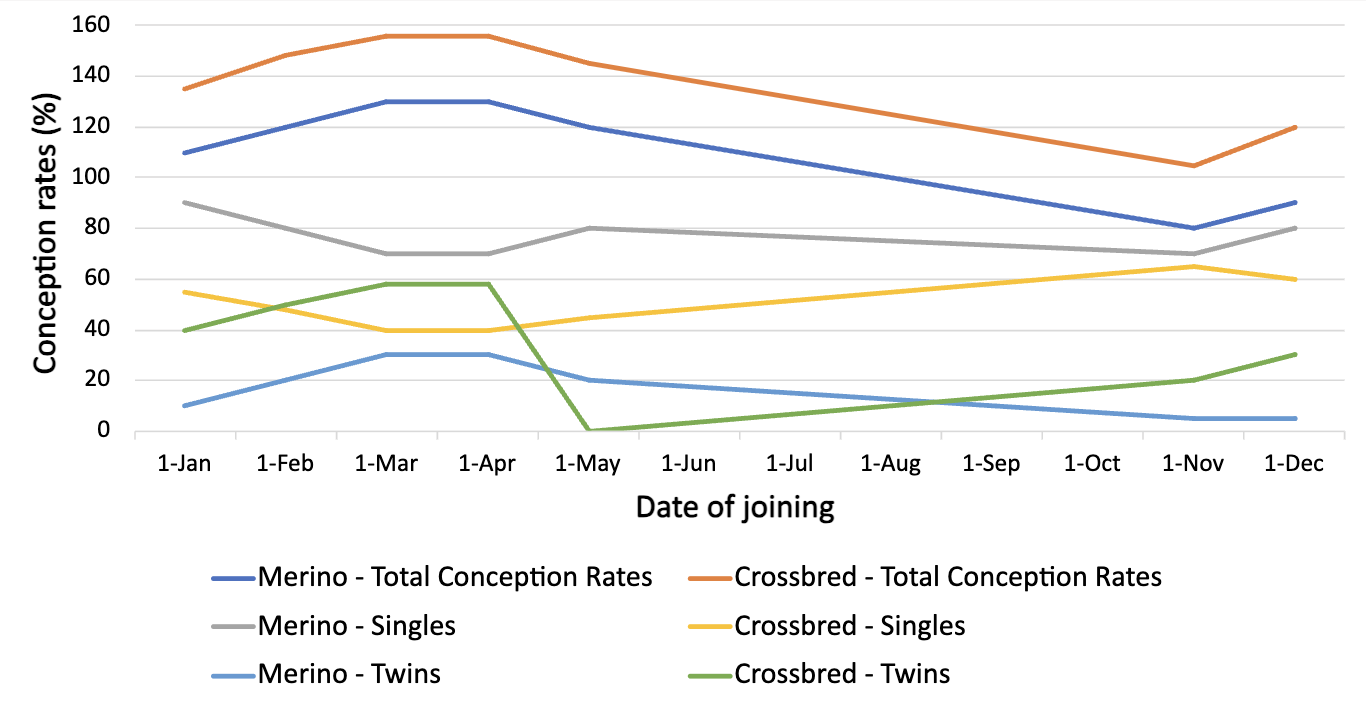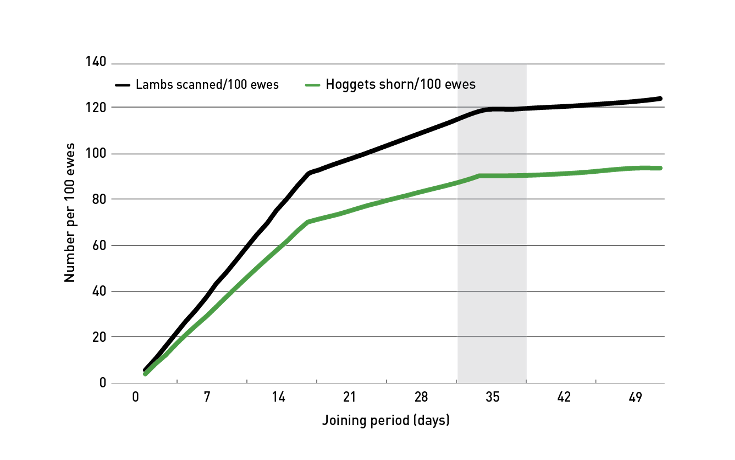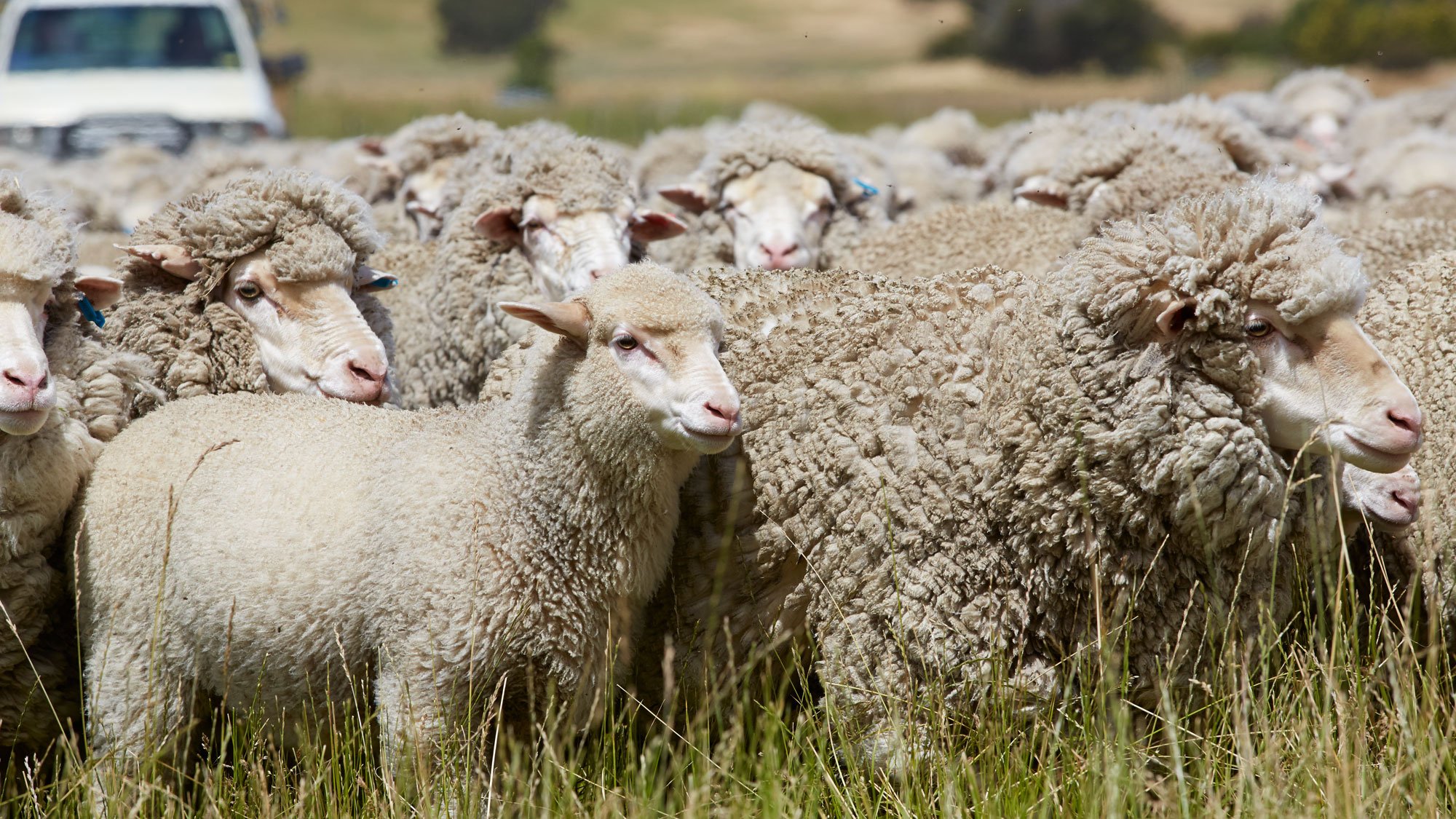Chapter 10.1 Ensure most ewes get in lamb
Background information
Successful joining management starts from the previous weaning period, both for ewes and rams. The first step to weaning more lambs is to ensure most ewes get pregnant in as short a joining period as possible. Both ewe and ram management must be considered.
The single most important determinant of reproductive rate is nutrition. Ewes in higher condition score conceive more lambs. A description of how to condition score (CS) is presented in tool 10.1. Use the recording sheets in tool 10.1 to plot the CS distribution in the mob.
The CS at joining is a more important indicator of reproductive rate than a change in CS through the joining period (unless extreme loss occurs). Adopt grazing management strategies to keep ewes in as high a CS as possible, rather than feeding ewes to increase reproductive rates.
At a glance
- Aim to have all ewes in condition score 3 or better at joining.
- Maiden ewes need to be at least 75-80% of their mature weight at joining.
- Select and prepare rams 2-3 months before joining starts.
- Choose a lambing time to match quality feed supply.
Timing of lambing
Where practical, aim to lamb a month before peak pasture production. This will allow your sheep to express their reproductive potential and give you the best opportunity to match pasture supply to the energy requirements of the ewes. In a lamb production enterprise, you may choose to compromise between number of ewes joined per hectare, likely reproductive rate, lamb sale weight and timing and market price.
If your favoured lambing time does not match your peak pasture growth, additional supplements may be needed to maintain production and prepare ewes for the next joining. Other influences include the market choice and planned growth rates of lambs to meet market specifications (see chapter 3.1 and chapter 3.2 in MMFS Module 3 Market Focused Lamb and Sheepmeat Production).
Timing of joining
Setting the time of joining for lambing is the most important on-farm management decision you make. In the most profitable systems lambing time is planned to match feed demand with feed supply (see chapter 8.3 in MMFS Module 8 Turn Pasture into Product). Use tool 10.2 to vary the management calendar for a breeding flock.
Oestrus activity in ewes increases after the longest day of the year (22 December in Australia). As day length shortens, cycling activity increases to peak between March and May when most ewes are cycling and with higher ovulation rates. From an evolutionary point of view the best time to lamb is spring, to align the ewe’s nutritional demand and with the period of greatest feed supply.
Cycling in Merinos is least affected by day length. Breeds such as Border Leicester, Coopworth and Romney are most affected by day length. Typical conception rates for Merino and crossbred ewes are shown in figure 10.1.
For out of season joining, cycling activity can be improved by the use of teasers and exploiting the ram effect to stimulate oestrus in ewes (see tool 10.3).

Figure 10.1 Conception rate of Merino and Border Leicester ewes at different joining times.
Source: Sheep CRC Report 1.2.6, adapted by AWI and MLA
Managing ewe nutrition
Managing ewe nutrition is the most important factor to ensure best reproductive performance. Condition scoring is a quick and reliable Tool for managing ewes to meet production targets and enable timely decisions to optimise reproduction rates (see tool 10.1). The actual condition score (CS) of the ewes is the most important determinant of ovulation rate.
The target CS at joining is a balance between reproductive performance, stocking rate and the cost of achieving that score. The response to reproductive rate in Merinos is linear between ewes in CS 1.5 to 4.5 (at CS 4 or higher the risk of dystocia increases). The Lifetimewool project shows an increase of about 20% extra lambs for each extra CS at joining. This response varies from 7% to 36%, depending on genetics and time of lambing, with later lambing likely to be more responsive.
Strategies to manage ewes for higher CS at joining include:
- At weaning, CS ewes (see tool 10.1) and draft those below score 3 into a separate management group for preferential grazing on pasture, or if pasture quality is low, feeding a supplement to increase liveweight. Pasture is usually the only economic option for increasing ewe condition score after weaning. The target is to get all ewes up to score 3 or better by joining (see chapter 10.5).
- Wean lambs no later than 14 weeks after the start of lambing to ensure ewes can gain weight on green pasture to reach the target of CS 3 before next joining.
Minimum CS 3 is the target for ewes at joining (see tool 10.4). Refer to tool 10.5 for guidelines for the growth path of maiden ewes.
It is important to determine the relative benefit of supplementary feeding to wean more lambs.
Joining management

Managing ewes at joining
The following management aspects need attention in breeding flocks:
- Join maiden ewes and adults separately as they have different ram requirements.
- Ewe health is extremely important. Any health issue such as worm burdens, liver fluke or footrot will slow weight gain or cause weight loss resulting in lower reproductive rates (see chapter 11.2 and chapter 11.3 in MMFS Module 11 Healthy and Contented Sheep).
- Avoid joining ewes within two weeks of shearing as shearing can disrupt cycling activity for two weeks.
- Avoid joining ewes with full wool as joining can be physically more difficult.
- Avoid joining ewes on pastures that may be toxic to sheep. For example, high endophyte perennial ryegrass pastures may lower conception rates and lambing performance by as much as 20%, even without visible ryegrass staggers.
- Avoid severe stress (such as more than 1 kg liveweight loss per week or extreme variation in feed quality) when joining ewes, as embryo loss may be higher.

Managing rams for joining
Ram management is important to a successful joining:
- Give rams a breeding soundness examination at least 8-12 weeks before joining (see tool 10.6).
- Shear rams at least eight weeks before joining as shearing cuts and resulting fever, or compromising temperature change, may affect semen quality.
- Join rams at 1% plus one extra ram for mature ewes (at least five rams for a mob of 400 ewes), at least 1.5% for maiden ewes and 2% for ewe lambs.
- Increase the ram percentage if you’re joining in large mobs as the ‘plus one extra ram’ gets more diluted the larger the mob gets.
- Higher ram joining rates are necessary in large paddocks with multiple watering points or when rams are joined outside the main breeding season.
- Avoid open gates between paddocks at joining. This is common when joining on crop stubbles to allow sheep access to several paddocks but can reduce ram contact with ewes on the specific days that they are cycling.
- Target CS for rams is 3.5. If your rams need to increase CS before joining, feed a high-quality feed such as lupins for 50 days prior to ensure maximum testes size and sperm output.
- Avoid joining inexperienced rams with maiden ewes. Use young rams with mature ewes and mature rams with young ewes.
- Minimise the risk of lambing difficulties by not joining meat breeds with high Australian Sheep Breeding Values (ASBVs) for birth weight to maiden ewes.
- Allow eight weeks for newly introduced rams to acclimatise if they have been brought in from outside your district. Housed rams may need even more time to become accustomed to paddock feed before joining commences.
- If ewes are being supplemented during joining, make sure rams are accustomed to the same supplementary feed as ewes to avoid acidosis.
Length of joining
Join rams with ewes for five weeks (two, 17-day cycles). If your flock is joined outside the peak breeding season (before January or after June), use teasers to stimulate oestrus in ewes that aren’t cycling spontaneously. Most ewes get pregnant in two cycles, as shown in figure 10.2.

Figure 10.2 Length of joining – few extra lambs after 5 weeks.
Source: LifetimeWool, adapted by AWI
On more intensively run farms, extending the joining for longer periods is not recommended because the 2-4% of extra lambs born holds up completion of important management events such as marking and weaning. Delaying weaning for a few late lambs can result in serious worm burdens, leading to weight loss in both ewes and lambs. In winter lambing Merino flocks, the late lambs generally have poor survival rates because they have a lower bodyweight over summer. Late weaning also compromises ewe condition recovery in preparation for the next reproductive cycle.
Joining maiden ewes
Bodyweight is the critical factor with maiden ewes. Management practices such as regular monitoring of bodyweight (and condition score when ewes are getting closer to mature weight) are essential for a successful joining and a higher percentage of lambs weaned to ewes joined.
Grow maiden Merino ewes to be at least at 75–80% of standard reference weight (SRW, see tool 10.7) for successful joining (see tool 10.5).
Most crossbred and shedder ewe lambs (and some Merino bloodlines) can be successfully joined at 7–10 months. Liveweight at joining is critical – ewe lambs should reach a minimum of 45 kg bodyweight to achieve optimal performance. For each additional kilogram between 35-45 kg at joining, weaning rate increases by around 3%. You must also ensure that they have access to good quality feed during pregnancy to ensure that they are condition score 3 or better at lambing. Do not attempt joining at 7–10 months if adequate feed cannot be provided.
What if ewes fail to get in lamb?
When joining in the peak breeding season, at least 90% of Merino ewes and up to 98% of crossbred ewes get pregnant in the first two cycles. Pregnancy rates can be 10% lower if joined outside the normal breeding season.
If more than 15% of ewes are not pregnant in the target joining time an investigation to determine the reason for ewes failing to conceive is necessary.
Both ewe and ram problems can contribute to poor results. The most common causes are low CS, nutrition or ram health related. You should also consider pasture toxicities, including syndromes such as perennial ryegrass toxicosis (see chapter 11.4 in MMFS Module 11 Healthy and Contented Sheep) or oestrogenic clover infertility. Consult your animal health advisor to investigate problems.
Visit Sheep Genetics (see signposts) or to explore the possibility of including genetic traits that can help assist in higher lamb survival rates.
For Merinos and Maternals, producers can utilise birthweight (BWT), conception (CON), litter size (LS), ewe rearing ability (ERA), maternal behaviour score (MBS) and weaning rate (WR).
For Terminal sheep operations, producers can utilise birthweight (BWT), lambing ease (LE), number of lambs born (NLB), and number of lambs weaned (NLW).
SIGNPOSTS
WATCH
A ten-part video series centred around sheep reproduction. Tune in to hear a range of practical ways growers can influence sheep reproduction with the latest research and tools informed by the AWI-funded research and development outcomes.
- Episode 2 – Weaning to manage
- Episode 3 – Ram performance management
- Episode 4 – Ewe cndition scoring
- Episode 5 – Joining timing and length
READ
The interactions between pasture growth patterns, stocking rate, time of lambing and production are complex. The guidelines outlined in these handbooks give wool producers an optimum strategy for managing ewes ‘year in, year out’ to maximise production, ensure healthy ewes and deliver efficient feed allocation.
A series of guidelines and recommendations for managing ewe flocks throughout the year.
USE
Develop a drought feeding strategy for sheep or cattle by determining feed requirements for different age groups and pregnancy or lactation status.
A decision support software tool to help graziers improve the profitability of livestock production through more efficient use of pastures and supplementary feeds.
View feed budget tables based on feed on offer (FOO) for annual clover-based pastures and mixed perennial and annual pastures.
Analyse the quality of a range of feeds to understand the amount of energy, protein and digestibility of feed to allow for accurate feed budgeting. Provided by a number of organisations, including:
- Agrifood FEEDTEST
- NSW DPI Feed Quality Service
- Independent Lab Services (WA)
Assists sheep producers to proactively manage the nutrition of their ewe flock through the reproduction cycle utilising condition scoring feed on offer (FOO) assessments.
Assists sheep producers to proactively manage the nutrition of their ewe flock through the reproduction cycle utilising condition scoring feed on offer (FOO) assessments.
This tool provides a systematic basis for planning the management calendar for the breeding flock. The Lambing Planner is available as a hard copy or can be downloaded as an app.
The Feed on Offer Library allows users to estimate FOO and nutritive value of grazed pastures.
ATTEND
A practical, one-day workshop highlighting the key production benefits of superior genetics, plus feed management for improved reproductive performance and livestock productivity.
Designed for woolgrowers and is aimed at improving weaner management of their Merino flock, targeting 95% weaner survival to one year of age. WWW identifies key practical actions and tools for commercial enterprises to implement on farm to achieve this performance aim.
Hands-on workshop focused on improving ram performance and working longevity in commercial sheep enterprises. The workshop is designed increase the skill of producers across the key components of ram performance and impacts on overall breeding enterprise performance, including anatomy, physiology, spermatogenesis, metabolic demands, health, disease & biosecurity and the financial impact of the ram team.
Assists the commercial self-replacing Merino production sector in recognising and placing importance on the total lifetime productivity potential and value of their Merino ewes (fleece, meat and surplus stock) and identifying ‘passengers vs. performers’.
The course is delivered in small groups of 5-7 sheep producers that meet six times per year with a professional trainer. During these hands-on sessions, the group visits each participating farm and learns skills in condition scoring, pasture assessment and best practice ewe and lamb management to increase reproduction efficiency and wool production, mainly through reducing ewe and lamb mortality.






